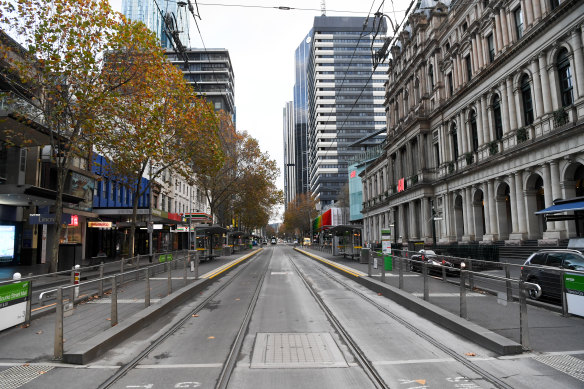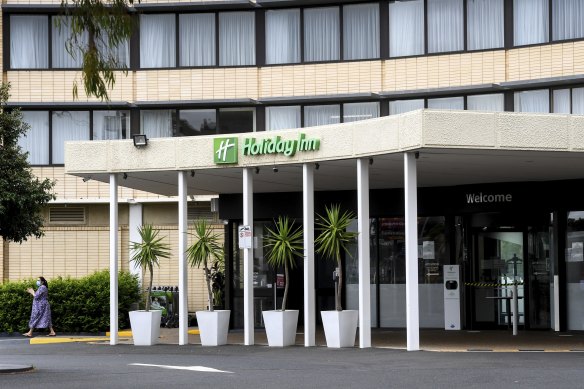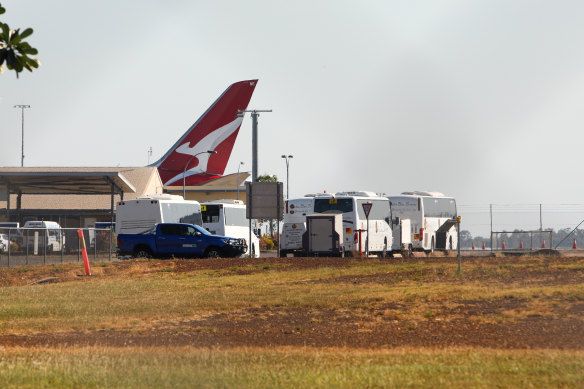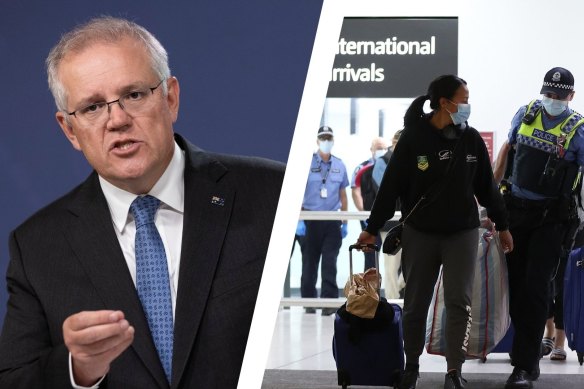This was published 3 years ago
Opinion
Clear leadership and purpose-built quarantine crucial to beating COVID
By Brendan Crabb and Mike Toole
Australia has managed the COVID-19 pandemic better than almost any other nation. The only significant threat since the devastating Victorian second wave has come from leaks in our hotel quarantine system.
Since November, 17 of them have occurred; seven in NSW, three each Victoria and Queensland and two each in South Australia and Western Australia. Fortunately, none of these led to another wave but all have been extremely costly and socially disruptive; all were potential time bombs.

Melbourne’s CBD is deserted as the state faces another lockdown caused by a quarantine leak in Adelaide.Credit: Justin McManus
Even though surveillance and contact tracing systems throughout Australia continue to improve, the variant SARS-Cov-2 viruses that they are dealing with are worse; they spread more rapidly than the original strain responsible for Victoria’s second wave.
The current Victorian outbreak is no different. A hotel quarantine leak, this time in South Australia, where an uninfected traveller caught the virus in hotel quarantine toward the end of his stay, should never have happened.
The traveller, who tested negative before exiting quarantine, returned to Melbourne and unwittingly set off the current chain of events which have put the state once again on red alert and facing strict restrictions. The details of how we got from the quarantine leak to 15,000 contacts across many sites are for another time but essentially it is down to bad luck.

An outbreak at the Holiday Inn at the airport in Melbourne prompted a five-day, statewide lockdown.Credit: Penny Stephens
The contact tracers have been excellent, but too much time had passed before crucial information came to their attention. It’s happened in other jurisdictions, asymptomatic transmission a potential culprit.
The key question is why this keeps happening. Does it have to keep happening? Some suggest that the quarantine failure rate of roughly one in 108 cases of infected returned travellers leaking into the community is not of concern and that we should be able to cope with that rate of leakage.
We categorically reject such a suggestion. The truth is that the vast majority – if not all – of these leaks are avoidable. Each of the escapes was probably driven by airborne transmission of the virus. Along with others, we have written extensively on its emerging significance as a major mode of COVID-19 spread in indoor, poorly ventilated settings. We won’t revisit that here except to say that in Australia (and elsewhere) official language, advice and policy frameworks have lagged behind this reality.
So what do we do now? In the immediate term, as trivial as it sounds, what we desperately need is an unambiguous acknowledgement of the importance of airborne transmission from the top.
Overturning traditional dogma, a theory that goes back to the early 20th century, which has affected all of our thinking (health experts and policy makers alike), needs a statement of crisp forcefulness from Australia’s top leaders. You can’t edge your way to overturning dogma. You have to crash through. If nothing else was done, this alone would set the tone for others to act whether they be within the federal or state and territory domain.

Buses wait to transport passengers from a flight to the Howard Springs quarantine facility.Credit: Getty Images
The second thing federal authorities should do is develop clear guidelines, or even better firm national standards, that can inform all airborne mitigation initiatives. Right now, this relates to quarantine but will also impact decisions relating to personal protective equipment and ventilation generally in the hospital setting and other workplaces.
Next, hotel quarantine needs urgent review in light of these new national standards that should be explicit about the important role of airborne transmission. It is important that this is national for a number of reasons. Significantly two of Victoria’s last three outbreaks have originated from interstate – NSW and SA. We can’t have a piecemeal approach to quarantine across the nation; we are obviously all interconnected as luckless Victorians can attest to.
And finally, we need purpose built quarantine facilities throughout the country. These facilities will achieve a number of aims. Clearly, purpose-built facilities like Howard Springs reduce the likelihood of COVID-19 escape more effectively than modified hotel quarantine. It is simply asking too much to retrofit hotels to be perfectly airborne-ready. But secondly, they can be used to increase capacity for people to travel into and out of the country. Protecting our precious COVID zero status, the cornerstone of our privileged health social and economic status, need not mean “Fortress Australia”.

Hotels are not the answer: A cohesive national approach to quarantine has been lacking.Credit: Getty, Brooke Mitchell
We are going to need quarantine facilities for quite some time given that the global burden of COVID-19 is too great to see a realistic end anytime soon. So purpose-built facilities that are safer and with substantially increased capacity provide Australia with a significant competitive advantage in economically important areas like foreign students, skilled migrants, seasonal workers and tourists.
COVID zero has paid off handsomely for Australia but its best days may even be ahead. And the key to that is to ensure we protect our borders in a way that keeps the virus out but welcomes people in.
Professor Brendan Crabb is an infectious disease researcher and chief executive at the Burnet Institute and Professor Mike Toole is a medical epidemiologist at the institute.